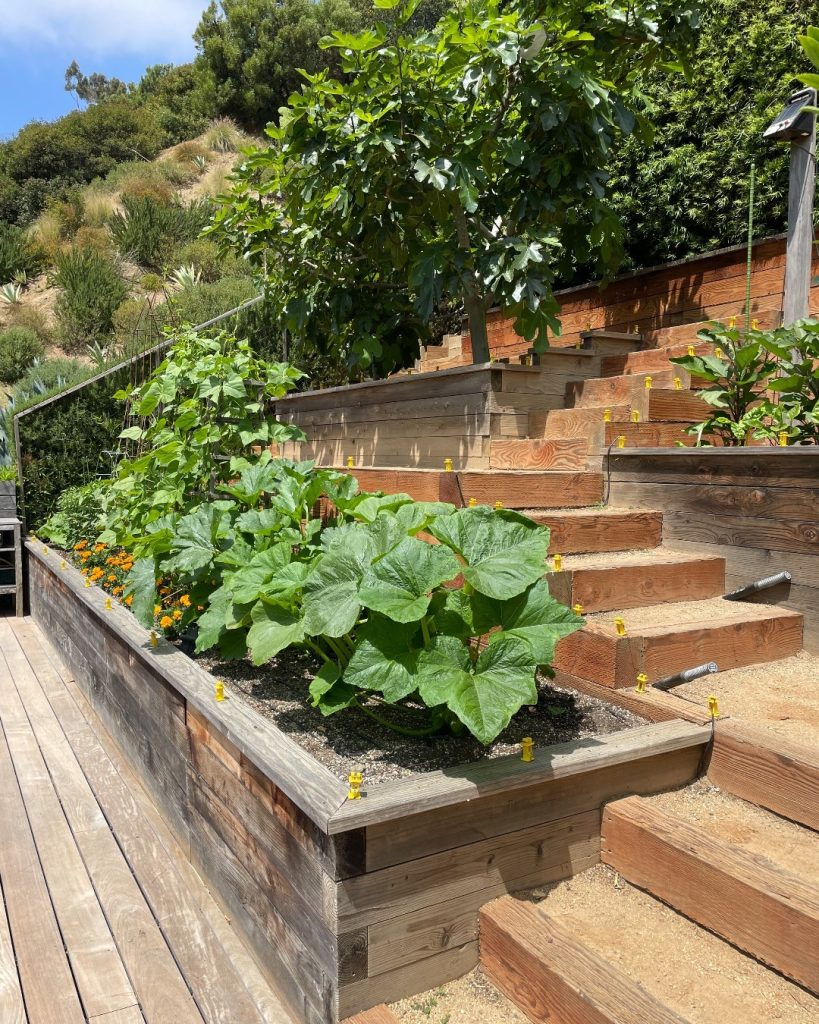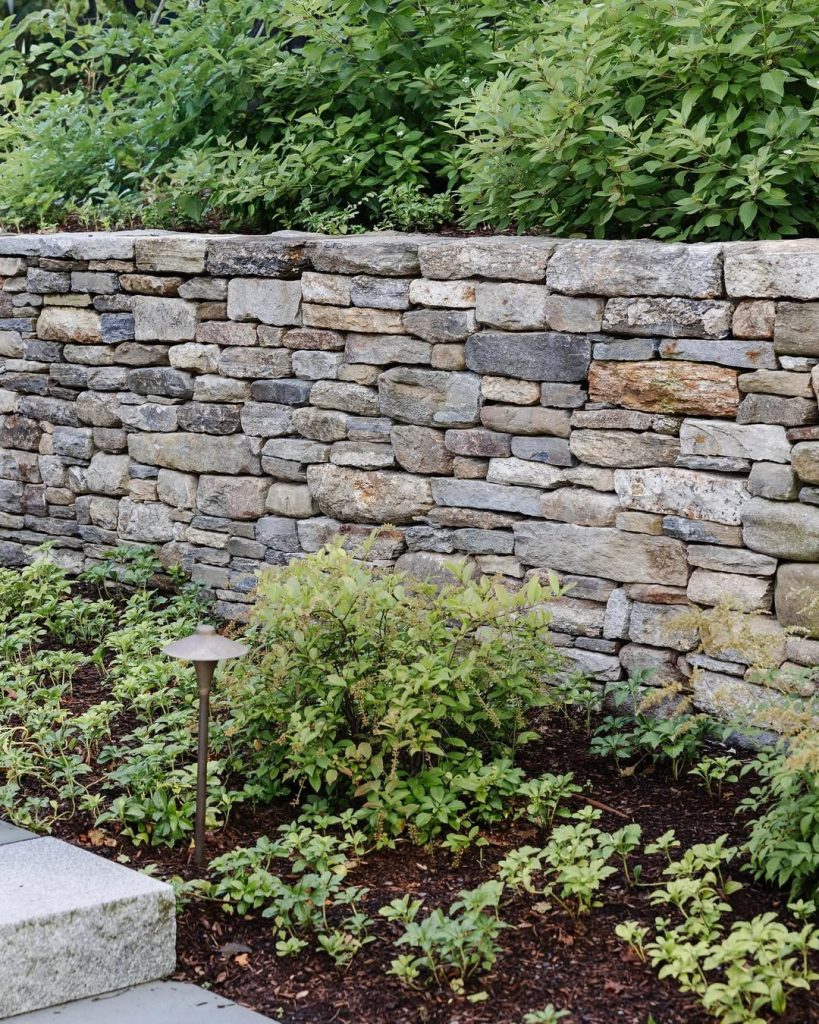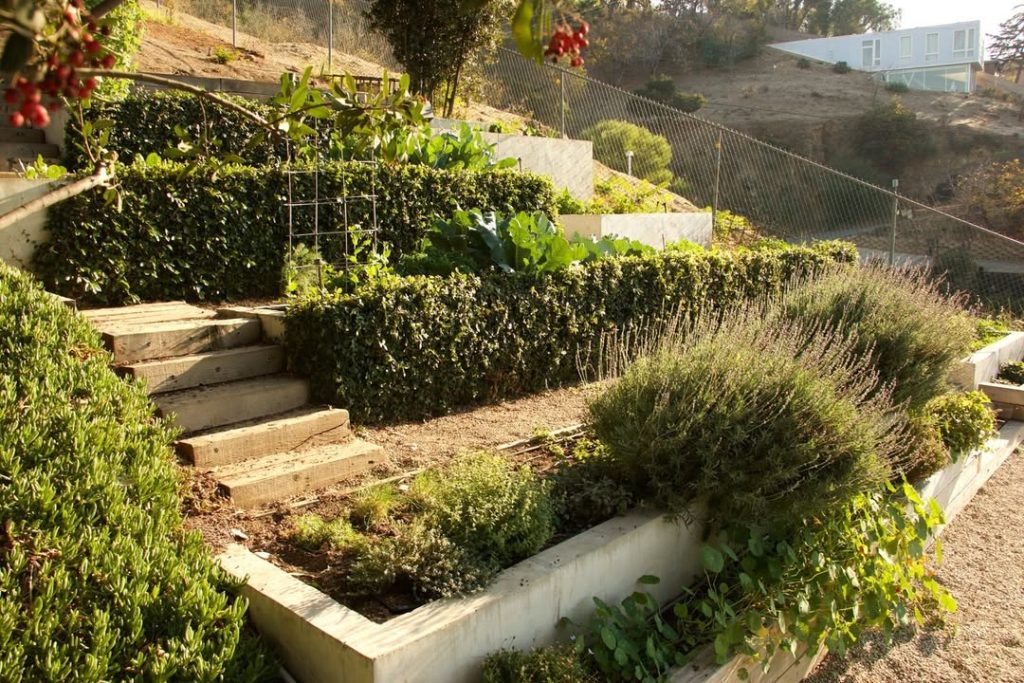If you’ve ever stared at your steep backyard hill and thought, What on earth do I do with this? — you’re not alone. Sloped yards can feel intimidating at first glance, but with a little creativity and the right inspiration, they can become one of the most eye-catching features of your entire outdoor living space.
Whether you want to create a peaceful retreat, a flower-filled haven, or a backyard that’s both functional and family-friendly, this list of 26 steep hill landscaping ideas will help you make the most of your sloped terrain.
These ideas range from beginner DIY projects to more advanced transformations, with plenty of beautiful, modern touches like stonework, terraced garden beds, and even cozy hillside seating areas. Get ready to turn your backyard hill into the stunning escape you didn’t know you needed.
Let’s dig in!
1. Terraced Garden Beds

If you’re dealing with a steep hill, terraced garden beds are a game-changer—not just for aesthetics, but also for usability. Think of them like natural outdoor steps, but filled with vibrant flowers, herbs, or even vegetables.
By creating several flat planting areas using retaining walls or timber, you’ll prevent soil erosion, increase planting space, and add visual structure to an otherwise difficult slope. Each level becomes its own mini-garden, allowing you to play with different themes—perhaps lavender and rosemary on one level, and bright blooms like coneflowers and zinnias on another.
You can build terraces using stone, wood, or concrete blocks depending on your style preference and budget. For a natural look, consider stacked stone or rough-hewn timber. For modern back porch ideas or contemporary yards, smooth concrete terraces blend beautifully with sleek patio furniture and clean lines.
Terracing not only transforms your slope into something useful and lovely, but it also increases your property’s curb appeal and resale value. It’s one of the best ways to truly work with your yard’s natural incline instead of fighting against it.
2. Stone Retaining Walls

Stone retaining walls are both beautiful and functional—two things every homeowner dreams of when dealing with a sloped yard. They add a sense of permanence, structure, and timeless elegance while also keeping soil in place and giving your hill much-needed definition.
If your hill is steep enough to be problematic, these walls are a fantastic solution. You can stagger several shorter walls up the slope or build one tall, dramatic wall depending on the size and shape of your outdoor space. Think limestone, granite, or fieldstone for a classic, natural appearance—or opt for smooth stacked blocks for a more modern outdoor living style.
Pair your retaining wall with lush greenery or flowing ornamental grasses like fountain grass or blue fescue for a soft touch. Don’t forget to consider built-in lighting or seating elements along the base of your wall, especially if it’s close to a modern patio area or your back porch.
Not only will this improve the usability of your landscape, but it also acts as a beautiful backdrop for gatherings or quiet evenings outdoors.
3. Tiered Flower Beds

If you love the idea of a flower-filled yard, tiered flower beds are a dream for steep hills. These gently layered beds allow you to showcase a wide variety of blooms, colors, and heights while giving your sloped yard definition and dimension.
Start by mapping out each level—this can be as formal or freeform as you like. Raised stone or brick borders give a clean, contained appearance, while timber or curved natural edges can evoke a more relaxed, cottage garden vibe.
This idea works wonderfully for gardeners who want to play with seasonal interest. Imagine spring tulips and daffodils in the top tier, summer daisies and bee balm in the middle, and fall mums and asters anchoring the bottom. It’s a cascading color show that transforms your hill into a year-round masterpiece.
Tiered beds are also an ideal spot for integrating decorative mulch paths, small retaining ledges, or even a bubbling water feature for added ambiance.
Plus, when these beds frame a back porch or lead toward a patio seating area, they create a sense of flow that makes your whole outdoor space feel intentional and harmonious.
4. Stepped Pathways with Gravel or Stone

Source
Want a way to safely and stylishly navigate your hill? A stepped gravel or stone pathway is one of the most practical and beautiful choices. It adds charm, guides the eye, and makes your sloped yard more walkable—especially if you want to connect various levels or access a garden nook.
Natural stone like slate or bluestone is perfect for a high-end, elegant look. For something more rustic, go with flagstone or pea gravel bordered by timber or bricks. Whichever style you choose, be sure to space your steps properly to create a gentle climb. Overly steep stairs can be uncomfortable and unsafe.
Incorporate landscape lighting along the path edges for added safety and an inviting glow in the evenings. Solar lights work well and are easy to install.
These pathways are especially beautiful when they weave between planting beds or alongside a retaining wall. They invite exploration and give your outdoor living space a curated, well-planned look—whether you’re heading to a back porch lounge zone or a tucked-away garden bench.
5. Hillside Rock Garden
Source
Rock gardens are a gorgeous, low-maintenance solution for steep slopes. They blend seamlessly with the natural terrain, require very little watering, and add loads of texture and interest to your landscape.
Start by selecting a variety of rocks—large and small—for contrast. Then strategically plant drought-resistant, slope-friendly greenery like sedum, hens and chicks, lavender, or creeping thyme. These plants not only thrive in rocky soil but also help anchor the hill and prevent erosion.
The key to a successful rock garden is layering. Mix boulders with pebbles, gravel, and plants of varying heights to create a natural-looking hillside that feels intentional and artistic.
Rock gardens are also great for modern backyards or those who want to avoid constant maintenance. They complement sleek, minimalist patio furniture and make the perfect transition between a contemporary back porch and a wild, natural slope.
You can even include a small stone bench or lantern to enhance the Zen-like vibe.
6. Natural Waterfall Feature
Source
There’s something undeniably soothing about the sound of flowing water—and a hillside offers the perfect setting for a cascading waterfall feature. Whether it’s a small, DIY stream or a professionally designed multi-tiered waterfall, this idea adds elegance and tranquility to your sloped backyard.
A natural waterfall feature starts at the top of your hill and flows downward, often ending in a small pond or catch basin. You can line the path with river rocks, boulders, and native plants for a woodland-inspired feel. Or opt for a more structured look with concrete basins and lighting for a modern twist.
This feature doesn’t just look beautiful—it can also help redirect water drainage and prevent erosion.
Position a seating area or back porch lounge zone nearby, and the sound of water becomes a calming soundtrack to your evenings. If you’re aiming for a high-end outdoor living experience, pairing your waterfall with modern patio furniture, soft lighting, and curated landscaping is a sure win.
7. Ground Cover Plants for Erosion Control
Source
One of the most practical and attractive ways to manage a sloped yard is by planting ground covers that prevent erosion. These low-growing, spreading plants form a living carpet across the hillside, holding soil in place and adding lush greenery or even pops of color.
Some great options include creeping juniper, vinca minor (also called periwinkle), sedum, and ajuga. These plants are all hardy, fast-growing, and require minimal upkeep once established.
Many of them are drought-resistant and thrive in challenging conditions, making them perfect for steep hills where mowing or maintaining traditional grass is impossible.
Ground covers also provide a soft, natural-looking transition between levels in your yard or between a back porch and a more wild, sloped area. If you want a more manicured feel, edge the area with stone borders or mulch paths for easy access and added polish.
They’re not only functional but also beautiful—especially when they bloom in spring or summer, adding unexpected color to your outdoor living space.
8. Sloped Wildflower Meadow
Source
If you’re dreaming of a backyard that feels like a peaceful country escape, a wildflower meadow is a wonderful way to transform a steep hill. This landscaping idea is perfect for homeowners who want to embrace a more natural aesthetic while also supporting local pollinators.
Start with a wildflower seed mix suited to your region’s climate—many are available specifically for slopes and erosion control. Scatter the seeds generously and water well during the early stages of growth. Once established, your hill will burst into seasonal blooms that attract bees, butterflies, and birds.
Wildflower meadows are incredibly low-maintenance. No mowing, no edging, and no pesticides. Just let nature do its thing. They pair beautifully with rustic wood features, stone paths, or even a nearby fire pit zone.
For those wanting to keep things semi-wild but a bit more structured, create curved edges or border your meadow with a small fence or stone wall for contrast.
It’s a beautiful, eco-friendly solution that turns a once-difficult slope into an ever-changing, living piece of art.
9. Stone Steps with Landscape Lighting
Source
Installing stone steps along a steep hill not only improves functionality—it creates a dramatic visual effect, especially when paired with soft landscape lighting.
Choose natural stone materials like slate, granite, or flagstone for a sturdy and stylish appearance. Then, incorporate small solar or low-voltage LED lights along the path. These lights can be embedded in the step risers, tucked into nearby plants, or mounted along a retaining wall.
Lighting not only enhances nighttime visibility but also adds a magical touch to your backyard. It’s perfect for those evenings when you want to sip something refreshing on your back porch and admire your beautiful landscape from above or below.
Stone steps and lighting also work well with modern outdoor furniture and patio designs, especially when you want to create a seamless connection between levels of your yard.
Whether you’re heading down to a fire pit, garden, or a cozy hammock nook, this setup makes the journey just as beautiful as the destination.
10. Stepped Retaining Walls
Source
When dealing with steep slopes, stepped retaining walls are a strategic and visually appealing solution. Instead of installing a single towering wall, this approach involves constructing a series of shorter walls with level areas in between. Each “step” can be used as a planting bed, outdoor seating area, or decorative tier, adding texture and interest to the slope.
Stepped walls work exceptionally well in large backyards where there’s a lot of vertical height to manage. They create usable flat spaces on an incline and help with erosion control and water management. These layers also add a structured and modern back porch appeal if placed adjacent to outdoor living areas.
You can build stepped retaining walls using stone, timber, or modern concrete blocks, depending on the look you’re going for. Stone walls bring a rustic elegance, while concrete lends itself well to clean, contemporary lines that pair beautifully with modern patio furniture.
With clever planting choices like cascading succulents, dwarf shrubs, or ground covers in between the steps, you can soften the look of the hardscape and create a terraced garden that blends seamlessly into the hillside.
11. Waterfall Feature
Source
A hillside is the perfect canvas for creating a dramatic waterfall feature. Gravity does most of the work on a slope, allowing water to flow naturally down multiple levels. The visual movement and soothing sound of water instantly elevate any outdoor space, transforming a basic incline into a serene retreat.
Waterfalls can range from naturalistic cascades tumbling over rocks to sleek, modern designs flowing over sculptural concrete forms. Either style fits beautifully with both rustic and modern back porch ideas. You can even incorporate lighting for a magical nighttime effect.
This type of feature doesn’t just add beauty—it also helps with erosion control. The water’s flow can be guided using gravel beds and hidden piping systems to reduce the impact of rainfall on bare slopes.
Pair the waterfall with lush plantings and a pond at the base, or place it adjacent to a back porch sitting area to create an unforgettable focal point. If you’re looking to integrate elegance with outdoor living functionality, this is one of the best upgrades you can make.
12. Stone Steps with Integrated Planters
Source
Combining steps and planters in one cohesive design makes for a stunning, dual-purpose solution on steep slopes. This idea involves building wide, stone or concrete steps and incorporating raised beds along the edges or even in the center.
Not only do these integrated planters break up the hardscape visually, but they also add color, texture, and seasonal interest. This concept is perfect for showcasing ornamental grasses, compact perennials, or fragrant herbs that brush your ankles as you ascend the stairs.
From an aesthetic standpoint, this design adds a softening touch to rigid architecture, balancing structure with nature. From a practical angle, planters help with slope stability and water absorption.
It’s also a wonderful way to add curb appeal or define an entryway to a lower-level patio. When styled with minimalist furniture and subtle lighting, the entire path can feel like an extension of modern patio decor.
13. Slope-Lined Pergola Path
Source
Adding a pergola-lined walkway down a hill creates a romantic, structured descent that invites exploration. By installing a pergola that follows the slope’s grade, you establish a sense of rhythm and shade, while simultaneously transforming an otherwise daunting slope into a usable, beautiful corridor.
The pergola supports can be wrapped with climbing vines such as wisteria, clematis, or roses, giving you a lush, botanical tunnel effect. The wooden or metal framework also offers opportunities to hang lanterns, string lights, or even lightweight outdoor curtains to add drama and ambiance.
This design feels like a hidden garden moment right in your backyard and aligns well with back porch decor centered around comfort and retreat. If you continue this path to a seating area or garden nook, it becomes more than a transition—it becomes a destination.
14. Gravel Switchback Trails
Source
Gravel switchbacks are a smart and visually interesting way to manage steep slopes. Instead of trying to tackle the incline directly, the trail winds gently back and forth, making it easier to walk and allowing for a longer, more scenic route.
This design is perfect for homeowners who want to enjoy the journey through their landscape, not just the destination. The switchbacks can be edged with stone or timber, and lined with native shrubs, succulents, or wildflowers that thrive in sloped conditions.
Switchback trails also integrate beautifully with outdoor living spaces. They can lead from an upper patio to a lower firepit zone or garden bench, making your backyard feel more expansive.
Gravel is an excellent material choice—it’s cost-effective, quick-draining, and blends well with both rustic and modern aesthetics. You can even mix in pea gravel for added comfort and elegance underfoot.
15. Hillside Fire Pit Lounge
Source
What could be cozier than a built-in fire pit nestled into a slope? Hillside fire pit lounges are a genius way to reclaim awkward terrain and turn it into an intimate gathering spot.
Digging into the slope allows you to create semi-circular seating that feels both enclosed and protected. The elevation difference also provides natural wind shielding, making the space even more comfortable on breezy evenings.
Surround the pit with stone or concrete retaining walls that double as benches. Add plush cushions, lantern lighting, and sleek modern patio furniture to round out the vibe. Whether you’re roasting s’mores with the family or sipping wine under the stars, it’s the ultimate outdoor living upgrade.
Consider surrounding the area with ground cover or decorative gravel to manage water runoff and reduce maintenance.
16. Gabion Walls
Source
Gabion walls are wire cages filled with rocks, used as retaining or decorative elements. They’re incredibly effective on steep hills due to their flexibility, drainage capability, and visual appeal.
The beauty of gabion walls lies in their rustic-meets-industrial charm. You can use different types of stone to create color contrast, or mix in glass pieces and recycled materials for a truly artistic touch. Their rugged appearance complements both natural landscapes and minimalist outdoor designs.
Because of their sturdy build and permeability, gabion walls help prevent erosion and allow water to pass through, reducing pressure on the slope. You can use them to form terraces, seat walls, or garden enclosures.
For those drawn to low-maintenance outdoor living, gabion walls offer a striking yet functional solution.
17. Vertical Garden Walls
Source
Maximize your vertical space by turning a hillside wall into a lush living tapestry. Vertical garden walls use mounted planters, pocket systems, or trellises to grow plants vertically, saving space and adding texture to sloped areas.
This concept is perfect for homeowners looking to incorporate greenery without sacrificing square footage. It’s also a clever way to soften concrete retaining walls or fences along the slope.
You can grow a wide variety of plants vertically—ferns, succulents, edibles like strawberries and herbs, or vibrant annuals. Vertical gardens are also ideal for adding a burst of back porch decor in otherwise hard-to-reach spots.
Incorporate automatic drip irrigation to make maintenance easy, and don’t forget to light it up at night for a magical, garden-wall effect.
18. Treehouse Deck Extension
Source
If you have a steep hill that drops off near your home, consider extending your deck outward like a treehouse platform. Elevated decks allow you to take full advantage of the view while creating usable square footage without major excavation.
This idea works particularly well if you have mature trees around the property—blend your build among the trunks for a true treehouse feel. Use horizontal railings, glass panels, or cable systems to preserve the view and add modern charm.
Pair this elevated space with sleek modern patio furniture and natural materials like hardwood or composite decking. Add potted plants, lanterns, and perhaps a swinging bench to finish off the look.
This floating deck extension becomes your personal overlook—a place to sip coffee, host friends, or just take in the sunset from your own slice of sky.
19. Natural Stone Staircase
Source
Few features elevate a hillside landscape quite like a natural stone staircase. Whether you go with flagstone, slate, or granite, the organic shape and texture of stone create a sense of permanence and elegance.
Natural stairs work well in both formal gardens and more rustic outdoor living designs. The key is proper installation—each step should be securely embedded into the hill with minimal rise and generous tread width to ensure safe and comfortable walking.
Add low-voltage lighting and flanking plants like hostas or lavender to create an inviting transition between elevation levels. A well-crafted stone staircase feels like a secret garden path, inviting you to explore further.
It’s both a functional necessity and a standout design feature for any sloped backyard.
20. Layered Flower Beds
Source
Layered flower beds are one of the most visually appealing and simple ways to landscape a steep hill. By breaking the slope into soft, planted tiers, you add color, movement, and biodiversity.
Start with sturdy edging materials—stone, timber, or corten steel—to define each level. Then fill them with a mix of perennials, annuals, and trailing plants for a dynamic, ever-changing landscape.
Choose plants suited to your climate and sun exposure. For example, in sunny spots, try lavender, salvia, and sedum. In shady areas, go for ferns, hostas, and astilbe.
This style supports pollinators, reduces erosion, and is ideal for those who enjoy seasonal garden transitions. Layered beds also enhance curb appeal and blend beautifully into natural surroundings.
21. Sloped Rock Garden
Source
A rock garden is a low-maintenance, drought-tolerant solution perfect for steep hills. It embraces a minimalist approach, using stones of various sizes interspersed with alpine plants, succulents, and ornamental grasses.
Rock gardens don’t just look great—they also help slow water runoff and prevent soil erosion. You can get creative with placement, building winding paths through the rocks or even incorporating small sculpture pieces or driftwood for added artistry.
This idea pairs well with back porch decor that leans rustic or zen-inspired. It creates a meditative, harmonious feel and requires very little upkeep once established.
A sloped rock garden is perfect for those seeking beauty with minimal effort.
22. Hillside Greenhouse or Potting Shed
Source
Make use of a slope by tucking a small greenhouse or potting shed into the hillside. This design not only makes smart use of space but also provides shelter from wind and extreme sun exposure.
The structure can be integrated into a retaining wall or carved into the slope with a green roof that blends into the landscape. From the front, it can have large glass panels to welcome light and warmth, perfect for extending your growing season.
Add decorative touches like lanterns, hanging tools, and even a little bistro table nearby to blend practicality with charm. This idea is ideal for those who enjoy back porch decor with a touch of cottage-core or farm-style inspiration.
It transforms a steep hill into a productive, cozy gardening hub.
Conclusion
Landscaping a steep hill may seem daunting at first, but it’s a golden opportunity to create something truly special. Whether you’re looking to improve function, enhance beauty, or simply make better use of your outdoor living space, the right design can turn a slope into your landscape’s biggest asset.
From water features and tiered gardens to modern patio extensions and rustic stone paths, these 26 ideas offer inspiration for every style and budget. With the right combination of creativity and planning, your hillside can become a layered, living masterpiece that elevates both your yard and your lifestyle.
Let your slope work for you—design it with purpose, plant it with joy, and enjoy it year-round.

